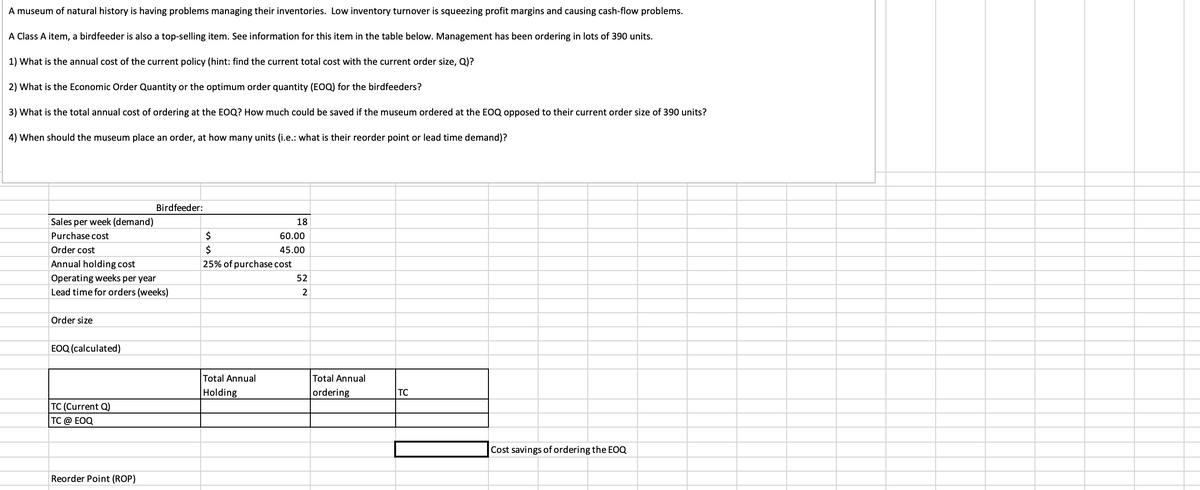A museum of natural history is having problems managing their inventories. Low inventory turnover is squeezing profit margins and causing cash-flow problems. A Class A item, a birdfeeder is also a top-selling item. See information for this item in the table below. Management has been ordering in lots of 390 units. 1) What is the annual cost of the current policy (hint: find the current total cost with the current order size, Q)? 2) What is the Economic Order Quantity or the optimum order quantity (EOQ) for the birdfeeders? 3) What is the total annual cost of ordering at the EOQ? How much could be saved if the museum ordered at the EOQ opposed to their current order size of 390 units?
A museum of natural history is having problems managing their inventories. Low inventory turnover is squeezing profit margins and causing cash-flow problems. A Class A item, a birdfeeder is also a top-selling item. See information for this item in the table below. Management has been ordering in lots of 390 units. 1) What is the annual cost of the current policy (hint: find the current total cost with the current order size, Q)? 2) What is the Economic Order Quantity or the optimum order quantity (EOQ) for the birdfeeders? 3) What is the total annual cost of ordering at the EOQ? How much could be saved if the museum ordered at the EOQ opposed to their current order size of 390 units?
Purchasing and Supply Chain Management
6th Edition
ISBN:9781285869681
Author:Robert M. Monczka, Robert B. Handfield, Larry C. Giunipero, James L. Patterson
Publisher:Robert M. Monczka, Robert B. Handfield, Larry C. Giunipero, James L. Patterson
Chapter16: Lean Supply Chain Management
Section: Chapter Questions
Problem 10DQ: The chapter presented various approaches for the control of inventory investment. Discuss three...
Related questions
Question

Transcribed Image Text:A museum of natural history is having problems managing their inventories. Low inventory turnover is squeezing profit margins and causing cash-flow problems.
A Class A item, a birdfeeder is also a top-selling item. See information for this item in the table below. Management has been ordering in lots of 390 units.
1) What is the annual cost of the current policy (hint: find the current total cost with the current order size, Q)?
2) What is the Economic Order Quantity or the optimum order quantity (EOQ) for the birdfeeders?
3) What is the total annual cost of ordering at the EOQ? How much could be saved if the museum ordered at the EOQ opposed to their current order size of 390 units?
4) When should the museum place an order, at how many units (i.e.: what is their reorder point or lead time demand)?
Sales per week (demand)
Purchase cost
Order cost
Annual holding cost
Birdfeeder:
Operating weeks per year
Lead time for orders (weeks)
Order size
EOQ (calculated)
18
$
$
60.00
45.00
25% of purchase cost
52
22
Total Annual
Holding
Total Annual
ordering
TC
TC (Current Q)
TC @ EOQ
Reorder Point (ROP)
Cost savings of ordering the EOQ
Expert Solution
This question has been solved!
Explore an expertly crafted, step-by-step solution for a thorough understanding of key concepts.
Step by step
Solved in 4 steps with 8 images

Recommended textbooks for you

Purchasing and Supply Chain Management
Operations Management
ISBN:
9781285869681
Author:
Robert M. Monczka, Robert B. Handfield, Larry C. Giunipero, James L. Patterson
Publisher:
Cengage Learning

Purchasing and Supply Chain Management
Operations Management
ISBN:
9781285869681
Author:
Robert M. Monczka, Robert B. Handfield, Larry C. Giunipero, James L. Patterson
Publisher:
Cengage Learning